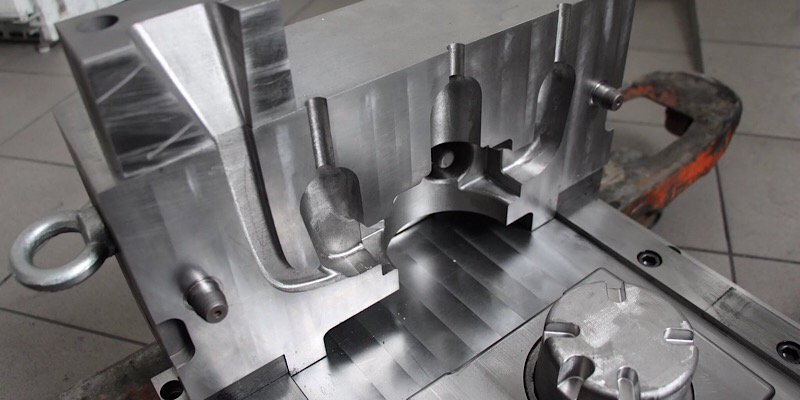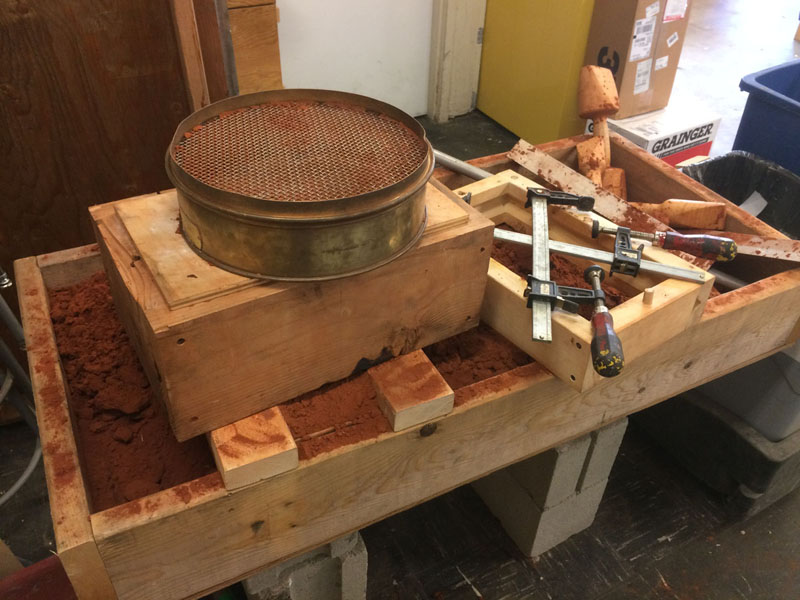How Aluminum Foundry Adds to Advancements in Aerospace Design
Aluminum factories are essential to developments in aerospace design. They produce light-weight, high-strength elements that are necessary for modern airplane. With sophisticated casting methods, these shops develop intricate geometries that improve structural stability. Additionally, the development of remarkable Aluminum alloys sustains the sector's emphasis on gas efficiency and sustainability. Nevertheless, obstacles remain in the production procedure. Comprehending these variables exposes the profound influence of Aluminum on aviation's future.
The Value of Lightweight Materials in Aerospace Layout
As the aerospace market continues to progress, the importance of light-weight materials comes to be increasingly apparent. The need for efficiency and sustainability drives designers to prioritize making use of materials that reduce general weight without jeopardizing structural stability. Light-weight materials, particularly Aluminum, play a crucial function in enhancing fuel efficiency, boosting haul capability, and boosting the overall efficiency of airplane.
In addition, the combination of these products enables ingenious styles, enabling producers to create even more wind resistant forms that can stand up to severe problems. The reduction in weight not just lowers functional prices but likewise adds to a reduced ecological footprint, lining up with global initiatives towards sustainability in air travel.
Advanced Spreading Techniques in Aluminum Foundries
Advanced spreading methods in Aluminum shops play an essential role in aerospace engineering by enabling the production of specific and light-weight parts. Innovations in mold style and accuracy spreading procedures are crucial in accomplishing ideal efficiency and architectural honesty. Additionally, the growth of light-weight alloys enhances the overall effectiveness and performance of aerospace applications.
Cutting-edge Mold And Mildew Layout
Ingenious mold style plays a vital role in the efficiency and performance of Aluminum shops, specifically within the aerospace field. By leveraging innovative products and strategies, modern-day molds can be engineered to hold up against high temperature levels and pressures, guaranteeing peak performance throughout the casting process. These designs often integrate intricate geometries that enable the manufacturing of light-weight yet structurally sound components, crucial for aerospace applications. Furthermore, making use of computer-aided layout (CAD) software helps with precise modeling, allowing foundries to refine and imitate mold and mildew designs before physical production starts. This not just improves the high quality of cast parts yet additionally minimizes waste and lead times, resulting in substantial price financial savings. Generally, innovative mold design is a cornerstone of development in Aluminum Foundry modern technology for aerospace engineering.
Accuracy Casting Procedures
The efficiency of innovative mold designs seamlessly incorporates with accuracy spreading procedures, which are essential for creating top notch Aluminum elements in aerospace design. These processes, consisting of sand casting, pass away spreading, and investment spreading, ensure the creation of complicated geometries with tight tolerances. Advanced techniques like vacuum casting and stress pass away casting enhance the stability and surface finish of the final items. Precision casting decreases product waste while maximizing the mechanical properties of Aluminum, vital for aerospace applications. Additionally, utilizing real-time surveillance and progressed simulation devices during the spreading procedure enables immediate adjustments, resulting in boosted high quality control. Collectively, these accuracy spreading procedures position Aluminum foundries at the forefront of aerospace innovation, supporting the sector's demand for integrity and performance.
Light-weight Alloy Development
As aerospace designers seek to boost gas efficiency and efficiency, light-weight alloy growth ends up being a crucial emphasis in Aluminum shops. These foundries use advanced casting strategies to produce alloys that give superior strength-to-weight ratios. Technologies in alloy make-up, consisting of the consolidation of components like lithium and magnesium, make it possible for the production of products that withstand severe conditions while minimizing total airplane weight. Methods such as die spreading and financial investment spreading help with the precision manufacturing of intricate shapes, which are essential for aerospace applications. Additionally, ongoing research intends to optimize these alloys for improved mechanical residential properties and enhanced resilience. By focusing on lightweight alloy growth, Aluminum factories considerably add to the evolution of aerospace design, leading the way for a lot more sustainable and reliable airplane layouts.

Enhancing Structural Honesty Via Aluminum Elements
Aluminum components provide significant advantages in enhancing structural honesty within aerospace engineering. Their lightweight nature adds to general performance while preserving toughness, which is vital for aircraft performance. Additionally, the anxiety resistance homes of Aluminum assistance assure the toughness and reliability of aerospace frameworks under various functional problems.
Light-weight Material Advantages
While standard materials frequently compromise weight for strength, making use of Aluminum parts in aerospace design offers significant benefits in architectural honesty. Aluminum's lightweight nature adds to total design performance, enabling more structured aircraft that take in less gas, therefore improving sustainability. The material's outstanding strength-to-weight ratio guarantees that elements maintain resilience without adding unnecessary mass. This quality fosters enhanced efficiency and dexterity in trip, in addition to maximized payload capabilities. In addition, Aluminum's resistance to rust extends the lifespan of aerospace frameworks, minimizing maintenance costs and boosting safety. As manufacturers visit this website increasingly adopt Aluminum alloys, the aerospace market experiences a transformative shift towards extra reliable and effective engineering options that focus on both performance and environmental responsibility.
Tension Resistance Qualities
Various materials have special buildings, Aluminum's extraordinary stress and anxiety resistance stands out as an important aspect in improving the structural honesty of aerospace elements. This resistance plays a crucial function in guaranteeing that aircraft can stand up to numerous functional stresses, consisting of fatigue, influence, and ecological problems. Aluminum alloys, especially engineered for aerospace applications, show high tensile strength while maintaining light-weight characteristics, allowing engineers to develop more reliable frameworks - Aluminum Foundry. In addition, the capacity of Aluminum to endure cyclic loading without substantial deformation adds to the long life and dependability of aerospace elements. As developments continue in Aluminum Foundry strategies, the growth of stress-resistant Aluminum components guarantees more renovations in efficiency, safety, and effectiveness across the aerospace sector, solidifying Aluminum's role as a recommended product in modern design
Fuel Performance Improvements Driven by Aluminum Innovations
As the aerospace market looks for to enhance fuel efficiency, ingenious uses Aluminum have actually arised as an essential option. Aluminum's lightweight nature especially lowers aircraft weight, permitting for reduced fuel intake during flight. This decrease in weight is vital, as even small declines can cause substantial improvements in overall gas economic climate.
Advanced Aluminum alloys, designed for boosted toughness and longevity, make it possible for producers to create components that maintain structural stability while minimizing mass - Aluminum Foundry. Furthermore, the assimilation of Aluminum in airframes and engine components facilitates improved the rules of aerodynamics, adding to reduced drag and increased performance
The adoption of Aluminum in aerospace not only satisfies the need for fuel-efficient style yet also aligns with regulatory pressures for lower discharges. As these developments remain to evolve, they play a substantial function in establishing brand-new criteria for fuel efficiency, guaranteeing that the aerospace industry can meet expanding environmental and economic challenges.

The Function of Aluminum in Sustainable Aeronautics Practices
The raising focus on lasting air travel practices has actually positioned Aluminum as an important product in the mission for greener airplane design. Recognized for its lightweight residential or commercial properties, Aluminum substantially decreases aircraft weight, causing reduced fuel usage and exhausts. Its recyclability better improves its sustainability profile, as Aluminum can be recycled indefinitely without loss of high quality. This particular supports a round economic situation within the aeronautics industry, reducing waste and resource depletion.
Advancements in Aluminum alloys have actually enhanced their stamina and deterioration resistance, allowing for longer service life and minimized maintenance requirements. These advancements help with the growth of a lot more reliable aircraft structures, adding to overall sustainability initiatives. Additionally, Aluminum's thermal conductivity plays a critical role in energy-efficient styles, boosting systems such as warmth exchangers. Jointly, these attributes highlight Aluminum's critical function ahead of time sustainable air travel, lining up with international efforts aimed at decreasing the ecological influence of flight.
Challenges Dealt With by Aluminum Foundries in Aerospace Manufacturing
While Aluminum factories play a vital duty in aerospace manufacturing, they encounter considerable obstacles that can affect production efficiency and high quality. One major difficulty is the stringent top quality control requirements needed in the aerospace market. Any flaw can jeopardize security and performance, requiring extensive evaluation procedures that expand manufacturing timelines. Additionally, foundries commonly emulate fluctuating basic material prices, which can influence pricing and productivity. The intricacy of Aluminum alloys utilized in aerospace applications more makes complex the production procedure, as specific formulas are important for attaining wanted mechanical properties. Proficient labor scarcities impede the ability to preserve top notch manufacturing levels. Ecological guidelines impose constraints on exhausts and waste administration, needing foundries to invest in lasting techniques, which can be cost-prohibitive. These aspects jointly create a landscape where Aluminum factories need to continually adapt to fulfill the progressing demands of aerospace production while making sure safety and security and compliance.
Future Patterns in Aluminum Applications for Aerospace Engineering
With advancements in technology and boosting demands for performance, the future of Aluminum applications in aerospace engineering is poised for significant improvement. The assimilation of ingenious Aluminum alloys and compounds is expected to boost strength-to-weight ratios, leading to more fuel-efficient aircraft layouts. Additionally, developments in additive manufacturing methods will enable the production of complex Aluminum frameworks that were formerly difficult, enhancing efficiency and minimizing from this source waste.

Sustainable practices will play a necessary role, with a growing emphasis on recycling Aluminum to reduce ecological influence. The aerospace sector is most likely to welcome smarter producing processes, such as automation and synthetic knowledge, making certain better and precision in Aluminum elements. Collaborations in between Aluminum factories and aerospace companies will promote study and advancement, leading the means for new applications that satisfy the rigid demands of modern-day aerospace engineering. Generally, the future looks guaranteeing for Aluminum's role fit the skies
Frequently Asked Questions
What Are the Ecological Impacts of Aluminum Manufacturing in Aerospace?
The ecological effects of Aluminum manufacturing in aerospace consist of substantial power intake, greenhouse gas emissions, and environment disruption. Furthermore, mining procedures can cause dirt deterioration and water contamination, increasing worries regarding sustainability and ecological balance.
How Does Aluminum Compare to Other Products in Aerospace Applications?
Aluminum offers a special combination of light-weight residential or commercial properties, rust resistance, and cost-effectiveness compared go to my site to other materials. Its high strength-to-weight ratio makes it especially helpful for aerospace applications, boosting gas performance and overall efficiency in airplane layout.
What Certifications Do Aluminum Foundry Employees Need for Aerospace Projects?
Aluminum Foundry workers require customized training in metallurgy and spreading methods, in addition to knowledge of aerospace market standards. Certifications in high quality control and security protocols are likewise important to ensure compliance with stringent aerospace project needs.
Are There Any Kind Of Security Worry About Utilizing Aluminum in Aerospace Engineering?
Safety concerns regarding Aluminum in aerospace engineering include susceptibility to exhaustion, deterioration, and stress and anxiety fractures. Correct therapy and alloy selection are vital to alleviate these threats, ensuring structural integrity and overall security in aerospace applications.
How Does Aluminum Recycling Advantage the Aerospace Sector?
Aluminum recycling significantly benefits the aerospace market by lowering material expenses, decreasing environmental effect, and preserving power. This lasting practice boosts the sector's effectiveness while advertising the usage of lightweight, high-performance elements in airplane manufacturing.
Advanced spreading strategies in Aluminum factories play a vital function in aerospace design by making it possible for the production of light-weight and exact components. Cutting-edge mold style plays an essential duty in the efficiency and effectiveness of Aluminum factories, specifically within the aerospace industry. As aerospace engineers look for to enhance fuel performance and performance, lightweight alloy development becomes an important emphasis in Aluminum foundries. Aluminum alloys, particularly engineered for aerospace applications, exhibit high tensile toughness while maintaining light-weight features, enabling designers to make extra reliable structures. Collaborations in between Aluminum factories and aerospace companies will certainly foster study and advancement, leading the method for brand-new applications that satisfy the strict requirements of modern-day aerospace engineering.